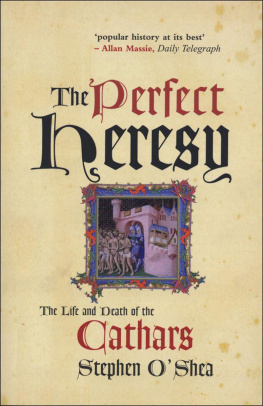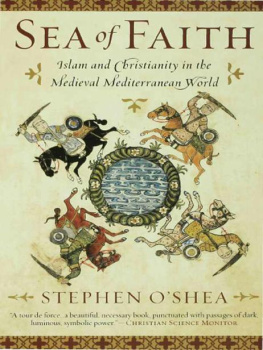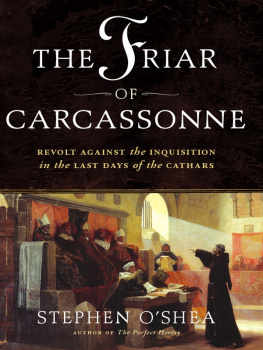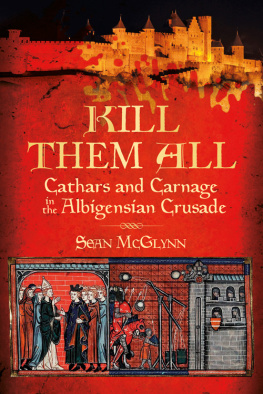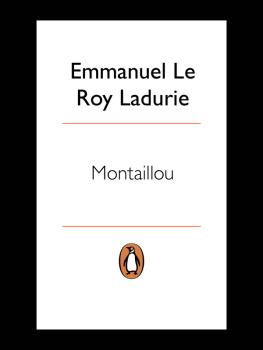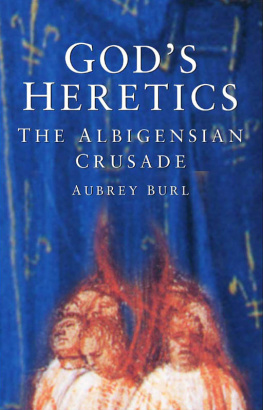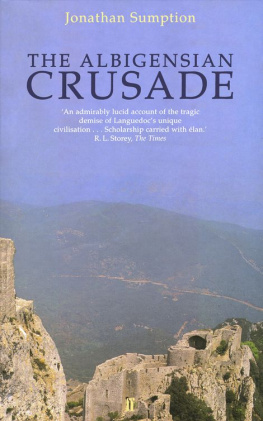Stephen OShea certainly knows how to tall a story, and he has chosen a rousing tale to tell. Cruelty, loyalty, heroism, fanaticism and cynicism on an epic scale are its lifeblood It is a story populated by knights and troubadours, saints and heretics, princes and the great anonymous crowds who suffered Stephen OShea brings this lost world of the thirteenth and early fourteenth centuries alive with stunning vividness.
Bernard Green, The Tablet
After nearly eight centuries, the memory one might almost say the spirit of the Cathars lives on in the land in which they lived, suffered and died. To anyone visiting the region for the first time, this book will be the ideal introduction to their story.
John Julius Norwich
The Perfect Heresy is the fascinating story of an unorthodox movement in the south of France from the twelfth to the fourteenth century. After its flowering, its ideas were destroyed in Languedoc by a crusade led by the king of France and the barons from the north of the country; the last remnants of Catharism came together in the village of Montaillou, in the Pyrenees, at the dawn of the fourteenth century. Stephen OSheas book is the work of a connoisseur of Languedoc, is written for a wide readership, and draws on his personal experience of Frances southern region.
Emmanuel Le Roy Ladurie, author of Montaillou
Apart from a racy, vivid account of the Crusade and the events that followed, he offers an intelligent analysis of the heresy and the conflicting theories surrounding it All the way OShea shows deep knowledge and love of the region. He writes with enthusiasm and immediacy of a contemporary chronicler The book is unputdownable.
Suzanne Lowry, Spectator
A very well-informed and highly readable account of one of the great religous and social crises of the Middle Ages. The Cathars have found in Stephen OShea a persuasive and passionate chronicler. This is a book to enjoy and ponder.
Norman F. Cantor, Emeritus Professor of History, New York University, and author of Inventing the Middle Ages and Medieval Lives
Stephen OShea is a Canadian writer and historian. He has lived for long periods in Paris and New York, and moved to southern France to research and write The Perfect Heresy . His first book, Back to the Front: an accidental historian walks the trenches of World War I , was published to great acclaim and his latest book, Sea of Faith is a magnificent narrative of the contacts and conflicts between Islam and Christianity in the Mediterranean world over a thousand years. He now lives in Providence, Rhode Island.
The Perfect Heresy
The Revolutionary Life and Death of
the Medieval Cathars
STEPHEN OSHEA


First published in Great Britain in 2000 by
Profile Books Ltd
3 A Exmouth House
Pine Street
Exmouth Market
London EC 1 R 0 JH
www.profilebooks.com
This edition published in 2001
First published in the United States of America in 2000 by Walker Publishing Company, Inc
10 9
Copyright Stephen OShea, 2000, 2001
Printed in the UK by CPI Bookmarque, Croydon, CR0 4TD
The moral right of the author has been asserted.
All rights reserved. Without limiting the rights under copyright reserved above, no part of this publication may be reproduced, stored or introduced into a retrieval system, or transmitted, in any form or by any means (electronic, mechanical, photocopying, recording or otherwise), without the prior written permission of both the copyright owner and the publisher of this book.
A CIP catalogue record for this book is available from the British Library.
ISBN-10 1 86197 350 0
ISBN-13 978 1 86197 350 4
To
Jill, Rachel, and Eve
Contents
Principal Figures in the
Cathar Story

SPIRITUAL FOES
Arnold Amaury (d. 1225): Head of the Cistercian order of monks. Papal plenipotentiary in Languedoc, he was later appointed archbishop of Narbonne. Arnold led the Albigensian Crusade at the infamous sack of Bziers in 1209.
Peter Autier (c. 12451309): Cathar holy man. Until middle age a wealthy notary in the mountain town of Ax-les-Thermes, Autier received heretical religious instruction in Italy and returned to Languedoc to spread the faith.
William Blibaste (d. 1321): The last Languedoc Perfect. Sought by the authorities on charges of heresy and murder, Blibaste exercised his ministry for over a decade among fellow exiles in Catalonia.
Bernard of Clairvaux (10901153): Cistercian monk, founder of the abbey of Clairvaux in Champagne in 1115, canonized in 1174. Bernard advised popes, preached the Second Crusade, and sounded the alarm about the growth of Catharism.
Blanche of Laurac : The greatest matriarch of Languedoc Catharism. Two of her daughters made prominent marriages, then became Perfect; another ran a Cathar home in Laurac. Blanches fourth daughter and only son were murdered at Lavaur in 1211.
Domingo de Guzmn (11701221): Founder of the Order of Friars Preachers, or Dominicans, canonized as St. Dominic in 1234. A native of Castile, Dominic preached tirelessly in Languedoc in the years preceding the crusade. During the Cathar wars he became a confidant of Simon de Montfort.
Esclarmonde of Foix : Sister of Raymond Roger, the count of Foix. Esclarmonde embraced Catharism in 1204 at a ceremony attended by Languedocs leading families. She ran a heretical convent and, centuries later, became the object of an eroticohistorical cult.
Jacques Fournier (c. 12801342): Cistercian monk of Languedoc peasant stock. Fournier, a peerless inquisitor, uncovered the Cathar revival at Montaillou. He was elected pope Benedict XII in 1334.
Fulk of Marseilles (11551231): Bishop of Toulouse from 1205 until his death. Immortalized by Dante in canto IX of the Paradiso , Fulk showed uncommon eloquence and ruthlessness in combating Catharism.
Gregory IX (11701241): Ugolino dei Conti di Segni, elected pope in 1227. His appointment, in 1233, of the Dominicans to lead the fight against heresy is usually cited as the founding act of the Inquisition.
Guilhabert of Castres (d. c. 1240): The greatest of the male Languedoc Perfect. Although in constant danger as the Cathar bishop of Toulouse, Guilhabert eluded capture and organized the strategic retreat of the faith into the Pyrenees.
Innocent III (11601216): Lotario dei Conti di Segni, elected pope in 1198. He launched the Albigensian Crusade in 1208 and convoked the Fourth Lateran Council in 1215. One of the most feared and admired medieval pontiffs, Innocent died in Perugia en route to brokering a peace between Genoa and Pisa.
Peter of Castelnau (d. 1208): Cistercian monk and papal legate whose demise prompted the call to crush the Cathars.
TEMPORAL RIVALS
Amaury de Montfort (11921241): Eldest son of Alice of Montmorency and Simon de Montfort. Embattled lord of Languedoc from 1218 until the cession of his rights to King Louis VIII of France. Captured by the Muslims at Gaza in 1239, held captive in Babylon for two years, Amaury died in Calabria on his homeward journey.
Blanche of Castile (11851252): Queen of France, then regent after the death of Louis VIII and during the minority of her eldest son, Louis IX (St. Louis), as well as during his extended crusading absences in Palestine. Arguably, Frances greatest thirteenth-century ruler.
Bouchard de Marly (d. 1226): First cousin of Alice of Montmorency and comrade-in-arms of her husband, Simon de Montfort. Held hostage for a time by Cathars in Cabaret, Bouchard subsequently led the second corps of cavalry at the battle of Muret.
Next page
